BUSM4409 - Literature Review: Automation and Robotics in Construction
VerifiedAdded on 2023/06/11
|12
|4659
|171
Literature Review
AI Summary
This literature review examines the application of automation and robotics in the construction industry, focusing on surveying processes, quality control, risk and safety analysis, innovation management, interface management, and new tools and components. It discusses the use of robotic total stations, laser scanning, LiDAR, BIM, and virtual reality for improved efficiency, safety, and sustainability. The review also explores the integration of lean construction principles, carbon emission reduction strategies, and advanced technologies for data exchange and risk identification. Furthermore, it highlights the development of new control schemes, computer programming languages, and structural components aimed at enhancing constructability and environmental friendliness, ultimately contributing to a better future through advanced integration between the construction and automation industries. The review concludes by emphasizing the importance of understanding automation and robotics for construction professionals, highlighting the evolution of automation from simple mechanization to complex control systems.
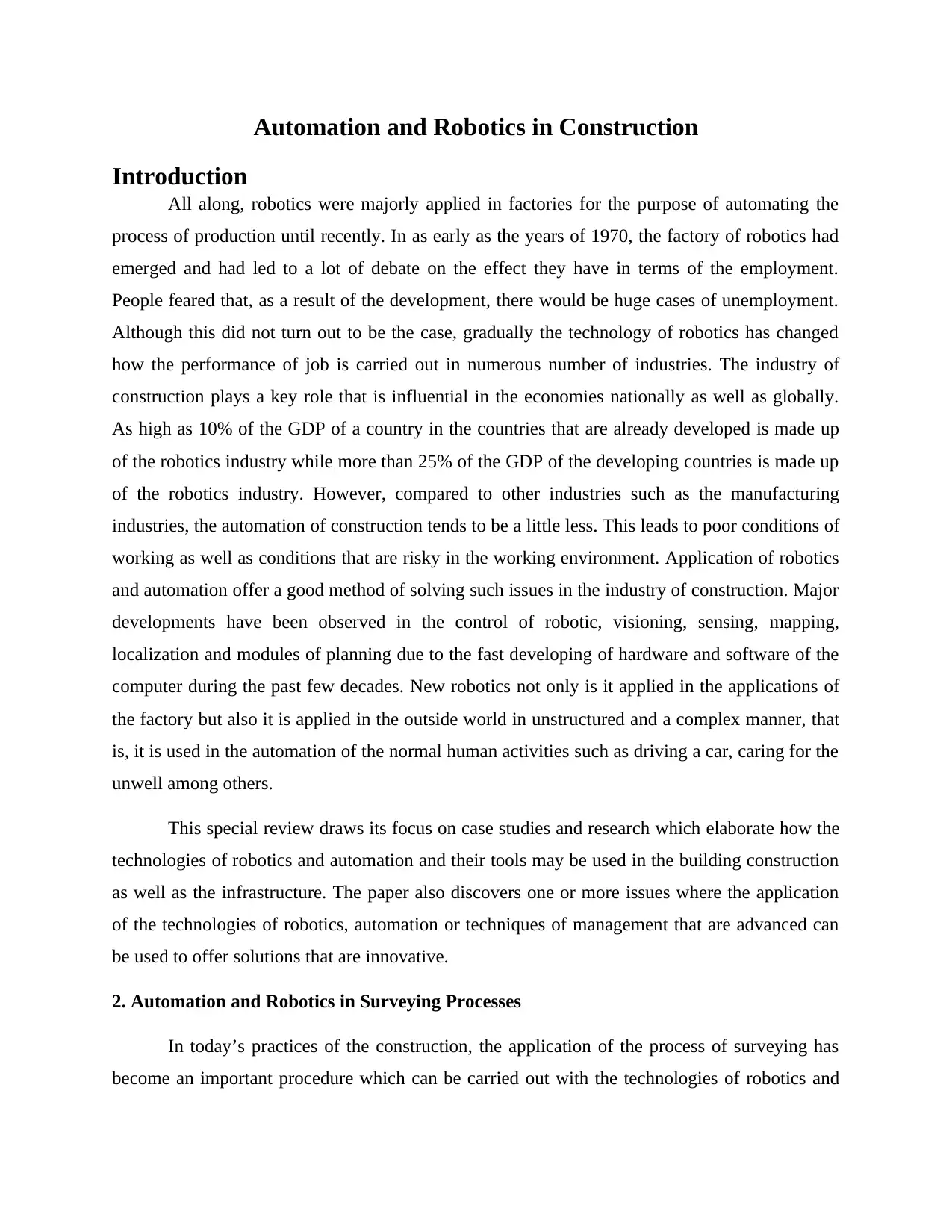
Automation and Robotics in Construction
Introduction
All along, robotics were majorly applied in factories for the purpose of automating the
process of production until recently. In as early as the years of 1970, the factory of robotics had
emerged and had led to a lot of debate on the effect they have in terms of the employment.
People feared that, as a result of the development, there would be huge cases of unemployment.
Although this did not turn out to be the case, gradually the technology of robotics has changed
how the performance of job is carried out in numerous number of industries. The industry of
construction plays a key role that is influential in the economies nationally as well as globally.
As high as 10% of the GDP of a country in the countries that are already developed is made up
of the robotics industry while more than 25% of the GDP of the developing countries is made up
of the robotics industry. However, compared to other industries such as the manufacturing
industries, the automation of construction tends to be a little less. This leads to poor conditions of
working as well as conditions that are risky in the working environment. Application of robotics
and automation offer a good method of solving such issues in the industry of construction. Major
developments have been observed in the control of robotic, visioning, sensing, mapping,
localization and modules of planning due to the fast developing of hardware and software of the
computer during the past few decades. New robotics not only is it applied in the applications of
the factory but also it is applied in the outside world in unstructured and a complex manner, that
is, it is used in the automation of the normal human activities such as driving a car, caring for the
unwell among others.
This special review draws its focus on case studies and research which elaborate how the
technologies of robotics and automation and their tools may be used in the building construction
as well as the infrastructure. The paper also discovers one or more issues where the application
of the technologies of robotics, automation or techniques of management that are advanced can
be used to offer solutions that are innovative.
2. Automation and Robotics in Surveying Processes
In today’s practices of the construction, the application of the process of surveying has
become an important procedure which can be carried out with the technologies of robotics and
Introduction
All along, robotics were majorly applied in factories for the purpose of automating the
process of production until recently. In as early as the years of 1970, the factory of robotics had
emerged and had led to a lot of debate on the effect they have in terms of the employment.
People feared that, as a result of the development, there would be huge cases of unemployment.
Although this did not turn out to be the case, gradually the technology of robotics has changed
how the performance of job is carried out in numerous number of industries. The industry of
construction plays a key role that is influential in the economies nationally as well as globally.
As high as 10% of the GDP of a country in the countries that are already developed is made up
of the robotics industry while more than 25% of the GDP of the developing countries is made up
of the robotics industry. However, compared to other industries such as the manufacturing
industries, the automation of construction tends to be a little less. This leads to poor conditions of
working as well as conditions that are risky in the working environment. Application of robotics
and automation offer a good method of solving such issues in the industry of construction. Major
developments have been observed in the control of robotic, visioning, sensing, mapping,
localization and modules of planning due to the fast developing of hardware and software of the
computer during the past few decades. New robotics not only is it applied in the applications of
the factory but also it is applied in the outside world in unstructured and a complex manner, that
is, it is used in the automation of the normal human activities such as driving a car, caring for the
unwell among others.
This special review draws its focus on case studies and research which elaborate how the
technologies of robotics and automation and their tools may be used in the building construction
as well as the infrastructure. The paper also discovers one or more issues where the application
of the technologies of robotics, automation or techniques of management that are advanced can
be used to offer solutions that are innovative.
2. Automation and Robotics in Surveying Processes
In today’s practices of the construction, the application of the process of surveying has
become an important procedure which can be carried out with the technologies of robotics and
Paraphrase This Document
Need a fresh take? Get an instant paraphrase of this document with our AI Paraphraser
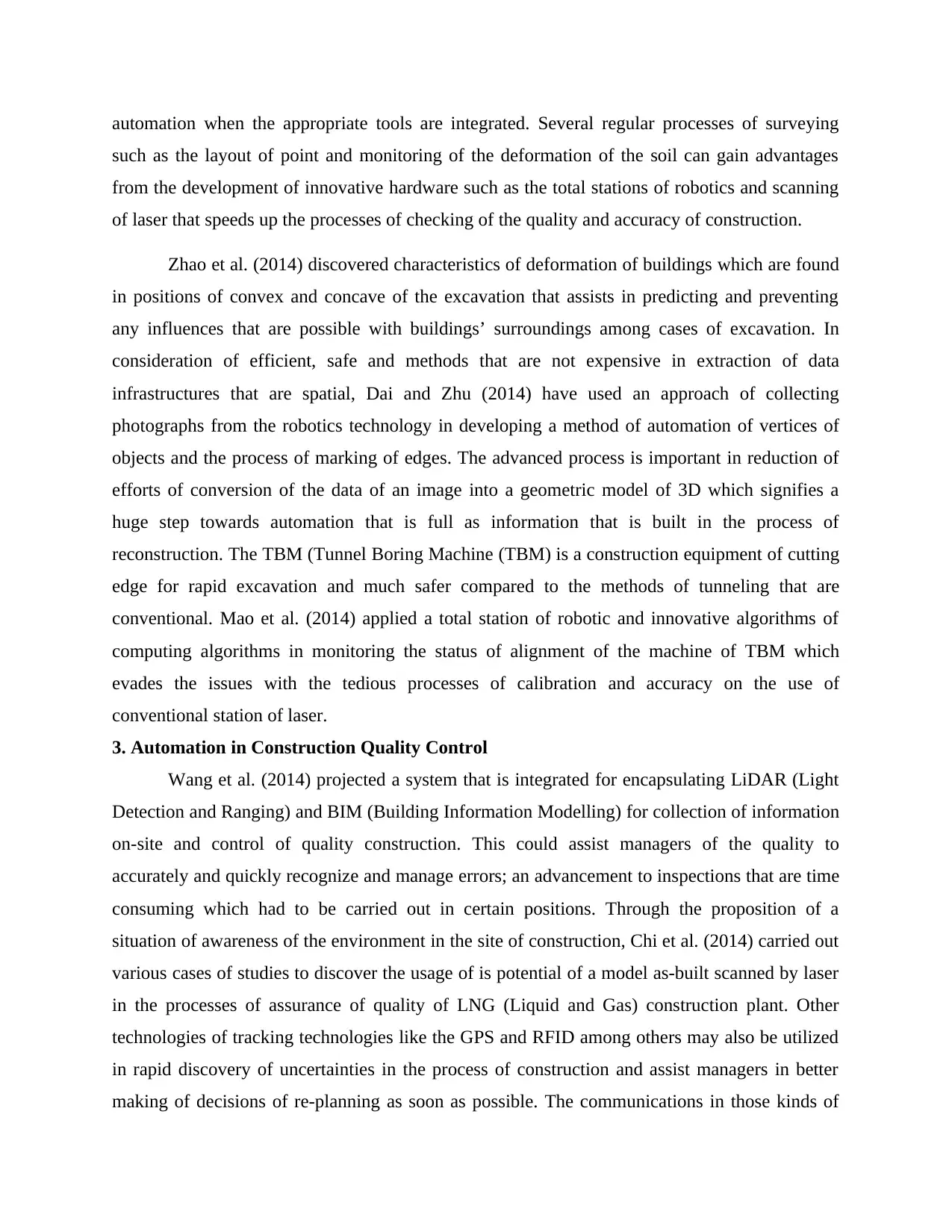
automation when the appropriate tools are integrated. Several regular processes of surveying
such as the layout of point and monitoring of the deformation of the soil can gain advantages
from the development of innovative hardware such as the total stations of robotics and scanning
of laser that speeds up the processes of checking of the quality and accuracy of construction.
Zhao et al. (2014) discovered characteristics of deformation of buildings which are found
in positions of convex and concave of the excavation that assists in predicting and preventing
any influences that are possible with buildings’ surroundings among cases of excavation. In
consideration of efficient, safe and methods that are not expensive in extraction of data
infrastructures that are spatial, Dai and Zhu (2014) have used an approach of collecting
photographs from the robotics technology in developing a method of automation of vertices of
objects and the process of marking of edges. The advanced process is important in reduction of
efforts of conversion of the data of an image into a geometric model of 3D which signifies a
huge step towards automation that is full as information that is built in the process of
reconstruction. The TBM (Tunnel Boring Machine (TBM) is a construction equipment of cutting
edge for rapid excavation and much safer compared to the methods of tunneling that are
conventional. Mao et al. (2014) applied a total station of robotic and innovative algorithms of
computing algorithms in monitoring the status of alignment of the machine of TBM which
evades the issues with the tedious processes of calibration and accuracy on the use of
conventional station of laser.
3. Automation in Construction Quality Control
Wang et al. (2014) projected a system that is integrated for encapsulating LiDAR (Light
Detection and Ranging) and BIM (Building Information Modelling) for collection of information
on-site and control of quality construction. This could assist managers of the quality to
accurately and quickly recognize and manage errors; an advancement to inspections that are time
consuming which had to be carried out in certain positions. Through the proposition of a
situation of awareness of the environment in the site of construction, Chi et al. (2014) carried out
various cases of studies to discover the usage of is potential of a model as-built scanned by laser
in the processes of assurance of quality of LNG (Liquid and Gas) construction plant. Other
technologies of tracking technologies like the GPS and RFID among others may also be utilized
in rapid discovery of uncertainties in the process of construction and assist managers in better
making of decisions of re-planning as soon as possible. The communications in those kinds of
such as the layout of point and monitoring of the deformation of the soil can gain advantages
from the development of innovative hardware such as the total stations of robotics and scanning
of laser that speeds up the processes of checking of the quality and accuracy of construction.
Zhao et al. (2014) discovered characteristics of deformation of buildings which are found
in positions of convex and concave of the excavation that assists in predicting and preventing
any influences that are possible with buildings’ surroundings among cases of excavation. In
consideration of efficient, safe and methods that are not expensive in extraction of data
infrastructures that are spatial, Dai and Zhu (2014) have used an approach of collecting
photographs from the robotics technology in developing a method of automation of vertices of
objects and the process of marking of edges. The advanced process is important in reduction of
efforts of conversion of the data of an image into a geometric model of 3D which signifies a
huge step towards automation that is full as information that is built in the process of
reconstruction. The TBM (Tunnel Boring Machine (TBM) is a construction equipment of cutting
edge for rapid excavation and much safer compared to the methods of tunneling that are
conventional. Mao et al. (2014) applied a total station of robotic and innovative algorithms of
computing algorithms in monitoring the status of alignment of the machine of TBM which
evades the issues with the tedious processes of calibration and accuracy on the use of
conventional station of laser.
3. Automation in Construction Quality Control
Wang et al. (2014) projected a system that is integrated for encapsulating LiDAR (Light
Detection and Ranging) and BIM (Building Information Modelling) for collection of information
on-site and control of quality construction. This could assist managers of the quality to
accurately and quickly recognize and manage errors; an advancement to inspections that are time
consuming which had to be carried out in certain positions. Through the proposition of a
situation of awareness of the environment in the site of construction, Chi et al. (2014) carried out
various cases of studies to discover the usage of is potential of a model as-built scanned by laser
in the processes of assurance of quality of LNG (Liquid and Gas) construction plant. Other
technologies of tracking technologies like the GPS and RFID among others may also be utilized
in rapid discovery of uncertainties in the process of construction and assist managers in better
making of decisions of re-planning as soon as possible. The communications in those kinds of
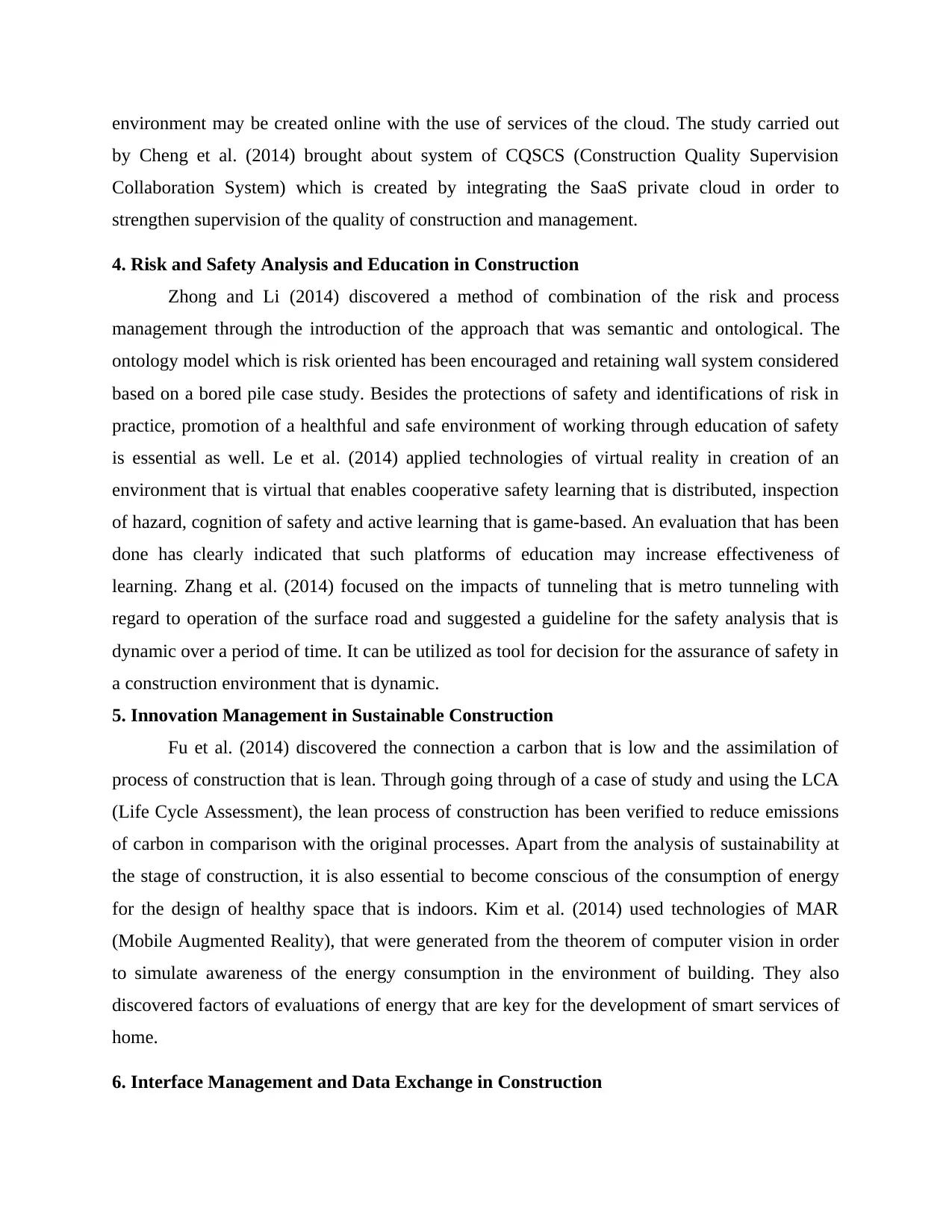
environment may be created online with the use of services of the cloud. The study carried out
by Cheng et al. (2014) brought about system of CQSCS (Construction Quality Supervision
Collaboration System) which is created by integrating the SaaS private cloud in order to
strengthen supervision of the quality of construction and management.
4. Risk and Safety Analysis and Education in Construction
Zhong and Li (2014) discovered a method of combination of the risk and process
management through the introduction of the approach that was semantic and ontological. The
ontology model which is risk oriented has been encouraged and retaining wall system considered
based on a bored pile case study. Besides the protections of safety and identifications of risk in
practice, promotion of a healthful and safe environment of working through education of safety
is essential as well. Le et al. (2014) applied technologies of virtual reality in creation of an
environment that is virtual that enables cooperative safety learning that is distributed, inspection
of hazard, cognition of safety and active learning that is game-based. An evaluation that has been
done has clearly indicated that such platforms of education may increase effectiveness of
learning. Zhang et al. (2014) focused on the impacts of tunneling that is metro tunneling with
regard to operation of the surface road and suggested a guideline for the safety analysis that is
dynamic over a period of time. It can be utilized as tool for decision for the assurance of safety in
a construction environment that is dynamic.
5. Innovation Management in Sustainable Construction
Fu et al. (2014) discovered the connection a carbon that is low and the assimilation of
process of construction that is lean. Through going through of a case of study and using the LCA
(Life Cycle Assessment), the lean process of construction has been verified to reduce emissions
of carbon in comparison with the original processes. Apart from the analysis of sustainability at
the stage of construction, it is also essential to become conscious of the consumption of energy
for the design of healthy space that is indoors. Kim et al. (2014) used technologies of MAR
(Mobile Augmented Reality), that were generated from the theorem of computer vision in order
to simulate awareness of the energy consumption in the environment of building. They also
discovered factors of evaluations of energy that are key for the development of smart services of
home.
6. Interface Management and Data Exchange in Construction
by Cheng et al. (2014) brought about system of CQSCS (Construction Quality Supervision
Collaboration System) which is created by integrating the SaaS private cloud in order to
strengthen supervision of the quality of construction and management.
4. Risk and Safety Analysis and Education in Construction
Zhong and Li (2014) discovered a method of combination of the risk and process
management through the introduction of the approach that was semantic and ontological. The
ontology model which is risk oriented has been encouraged and retaining wall system considered
based on a bored pile case study. Besides the protections of safety and identifications of risk in
practice, promotion of a healthful and safe environment of working through education of safety
is essential as well. Le et al. (2014) applied technologies of virtual reality in creation of an
environment that is virtual that enables cooperative safety learning that is distributed, inspection
of hazard, cognition of safety and active learning that is game-based. An evaluation that has been
done has clearly indicated that such platforms of education may increase effectiveness of
learning. Zhang et al. (2014) focused on the impacts of tunneling that is metro tunneling with
regard to operation of the surface road and suggested a guideline for the safety analysis that is
dynamic over a period of time. It can be utilized as tool for decision for the assurance of safety in
a construction environment that is dynamic.
5. Innovation Management in Sustainable Construction
Fu et al. (2014) discovered the connection a carbon that is low and the assimilation of
process of construction that is lean. Through going through of a case of study and using the LCA
(Life Cycle Assessment), the lean process of construction has been verified to reduce emissions
of carbon in comparison with the original processes. Apart from the analysis of sustainability at
the stage of construction, it is also essential to become conscious of the consumption of energy
for the design of healthy space that is indoors. Kim et al. (2014) used technologies of MAR
(Mobile Augmented Reality), that were generated from the theorem of computer vision in order
to simulate awareness of the energy consumption in the environment of building. They also
discovered factors of evaluations of energy that are key for the development of smart services of
home.
6. Interface Management and Data Exchange in Construction
⊘ This is a preview!⊘
Do you want full access?
Subscribe today to unlock all pages.

Trusted by 1+ million students worldwide
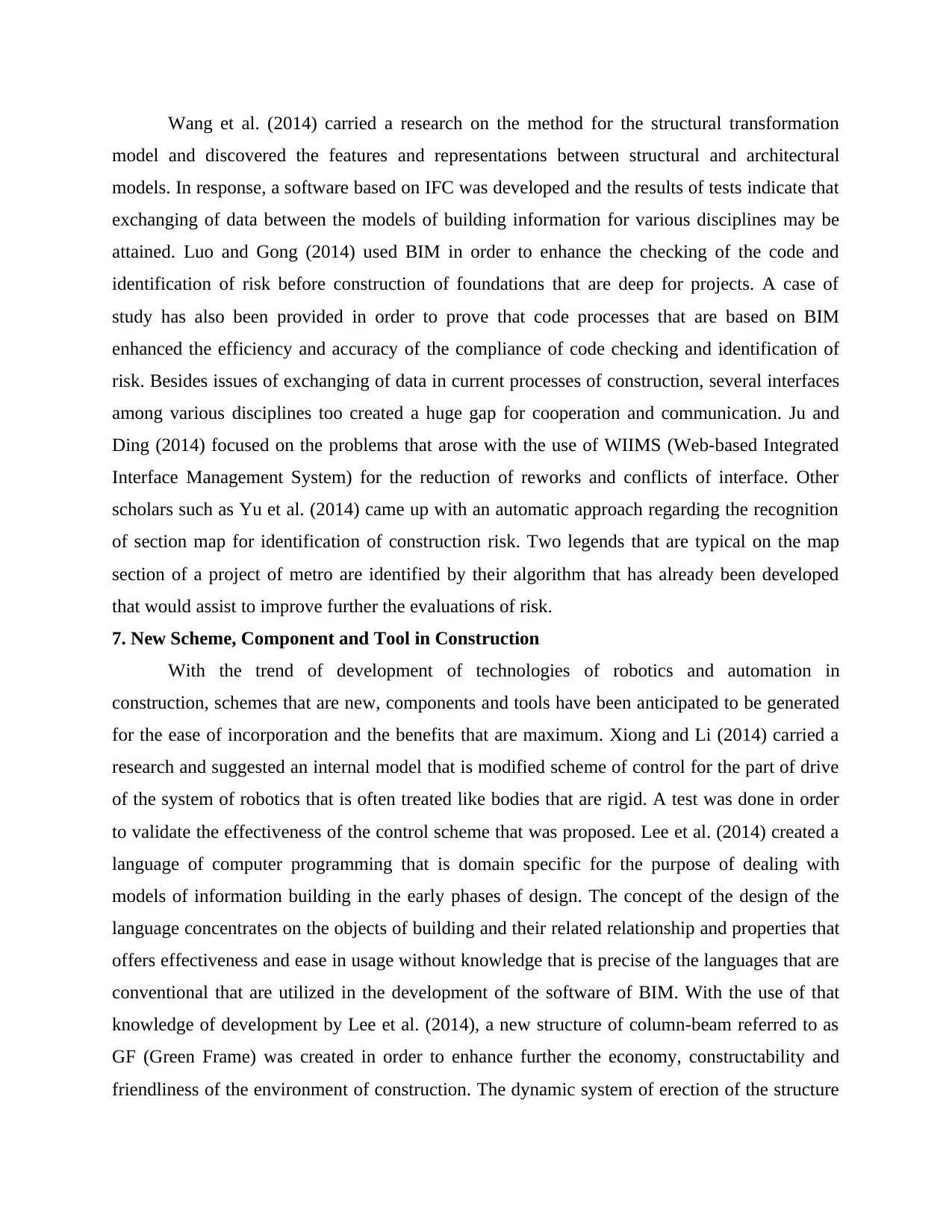
Wang et al. (2014) carried a research on the method for the structural transformation
model and discovered the features and representations between structural and architectural
models. In response, a software based on IFC was developed and the results of tests indicate that
exchanging of data between the models of building information for various disciplines may be
attained. Luo and Gong (2014) used BIM in order to enhance the checking of the code and
identification of risk before construction of foundations that are deep for projects. A case of
study has also been provided in order to prove that code processes that are based on BIM
enhanced the efficiency and accuracy of the compliance of code checking and identification of
risk. Besides issues of exchanging of data in current processes of construction, several interfaces
among various disciplines too created a huge gap for cooperation and communication. Ju and
Ding (2014) focused on the problems that arose with the use of WIIMS (Web-based Integrated
Interface Management System) for the reduction of reworks and conflicts of interface. Other
scholars such as Yu et al. (2014) came up with an automatic approach regarding the recognition
of section map for identification of construction risk. Two legends that are typical on the map
section of a project of metro are identified by their algorithm that has already been developed
that would assist to improve further the evaluations of risk.
7. New Scheme, Component and Tool in Construction
With the trend of development of technologies of robotics and automation in
construction, schemes that are new, components and tools have been anticipated to be generated
for the ease of incorporation and the benefits that are maximum. Xiong and Li (2014) carried a
research and suggested an internal model that is modified scheme of control for the part of drive
of the system of robotics that is often treated like bodies that are rigid. A test was done in order
to validate the effectiveness of the control scheme that was proposed. Lee et al. (2014) created a
language of computer programming that is domain specific for the purpose of dealing with
models of information building in the early phases of design. The concept of the design of the
language concentrates on the objects of building and their related relationship and properties that
offers effectiveness and ease in usage without knowledge that is precise of the languages that are
conventional that are utilized in the development of the software of BIM. With the use of that
knowledge of development by Lee et al. (2014), a new structure of column-beam referred to as
GF (Green Frame) was created in order to enhance further the economy, constructability and
friendliness of the environment of construction. The dynamic system of erection of the structure
model and discovered the features and representations between structural and architectural
models. In response, a software based on IFC was developed and the results of tests indicate that
exchanging of data between the models of building information for various disciplines may be
attained. Luo and Gong (2014) used BIM in order to enhance the checking of the code and
identification of risk before construction of foundations that are deep for projects. A case of
study has also been provided in order to prove that code processes that are based on BIM
enhanced the efficiency and accuracy of the compliance of code checking and identification of
risk. Besides issues of exchanging of data in current processes of construction, several interfaces
among various disciplines too created a huge gap for cooperation and communication. Ju and
Ding (2014) focused on the problems that arose with the use of WIIMS (Web-based Integrated
Interface Management System) for the reduction of reworks and conflicts of interface. Other
scholars such as Yu et al. (2014) came up with an automatic approach regarding the recognition
of section map for identification of construction risk. Two legends that are typical on the map
section of a project of metro are identified by their algorithm that has already been developed
that would assist to improve further the evaluations of risk.
7. New Scheme, Component and Tool in Construction
With the trend of development of technologies of robotics and automation in
construction, schemes that are new, components and tools have been anticipated to be generated
for the ease of incorporation and the benefits that are maximum. Xiong and Li (2014) carried a
research and suggested an internal model that is modified scheme of control for the part of drive
of the system of robotics that is often treated like bodies that are rigid. A test was done in order
to validate the effectiveness of the control scheme that was proposed. Lee et al. (2014) created a
language of computer programming that is domain specific for the purpose of dealing with
models of information building in the early phases of design. The concept of the design of the
language concentrates on the objects of building and their related relationship and properties that
offers effectiveness and ease in usage without knowledge that is precise of the languages that are
conventional that are utilized in the development of the software of BIM. With the use of that
knowledge of development by Lee et al. (2014), a new structure of column-beam referred to as
GF (Green Frame) was created in order to enhance further the economy, constructability and
friendliness of the environment of construction. The dynamic system of erection of the structure
Paraphrase This Document
Need a fresh take? Get an instant paraphrase of this document with our AI Paraphraser
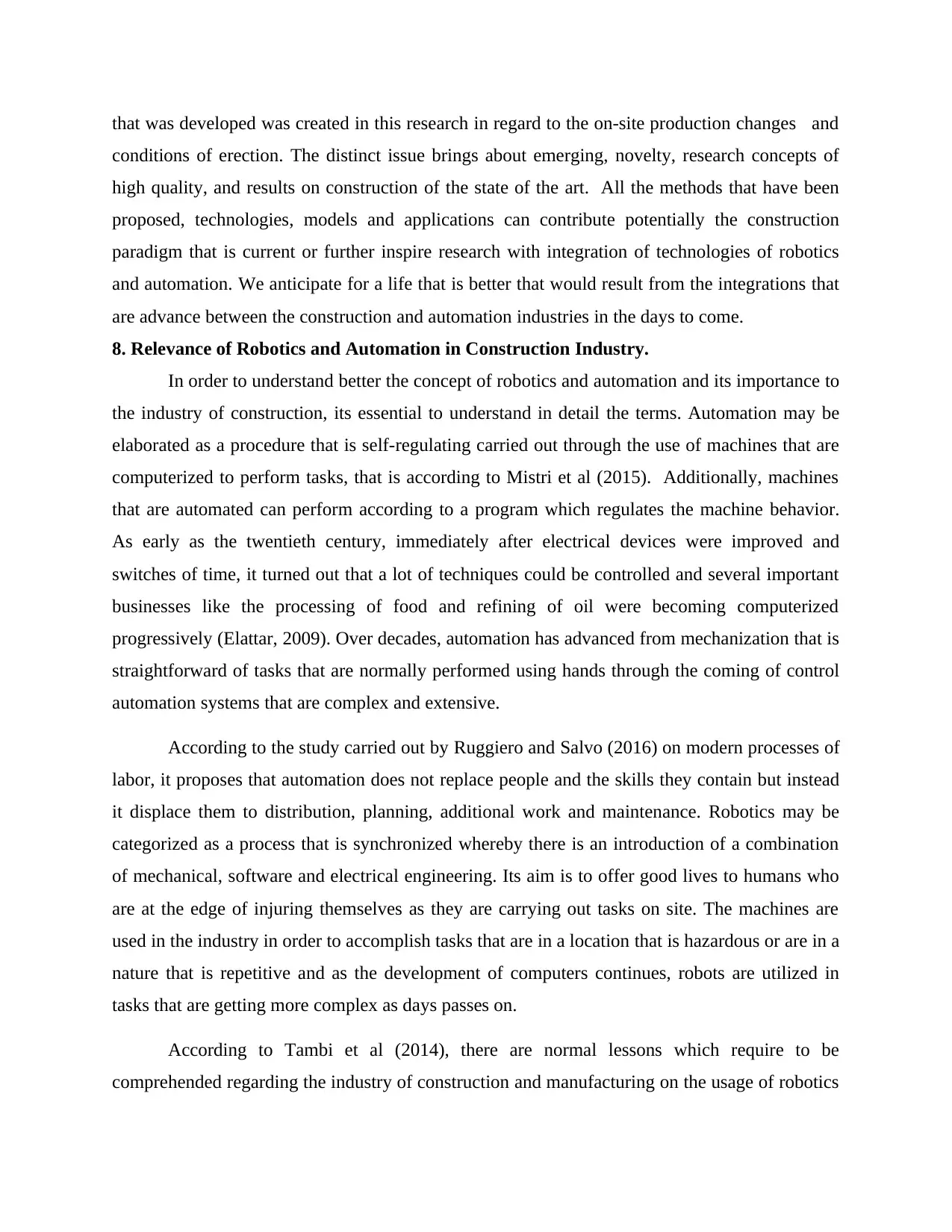
that was developed was created in this research in regard to the on-site production changes and
conditions of erection. The distinct issue brings about emerging, novelty, research concepts of
high quality, and results on construction of the state of the art. All the methods that have been
proposed, technologies, models and applications can contribute potentially the construction
paradigm that is current or further inspire research with integration of technologies of robotics
and automation. We anticipate for a life that is better that would result from the integrations that
are advance between the construction and automation industries in the days to come.
8. Relevance of Robotics and Automation in Construction Industry.
In order to understand better the concept of robotics and automation and its importance to
the industry of construction, its essential to understand in detail the terms. Automation may be
elaborated as a procedure that is self-regulating carried out through the use of machines that are
computerized to perform tasks, that is according to Mistri et al (2015). Additionally, machines
that are automated can perform according to a program which regulates the machine behavior.
As early as the twentieth century, immediately after electrical devices were improved and
switches of time, it turned out that a lot of techniques could be controlled and several important
businesses like the processing of food and refining of oil were becoming computerized
progressively (Elattar, 2009). Over decades, automation has advanced from mechanization that is
straightforward of tasks that are normally performed using hands through the coming of control
automation systems that are complex and extensive.
According to the study carried out by Ruggiero and Salvo (2016) on modern processes of
labor, it proposes that automation does not replace people and the skills they contain but instead
it displace them to distribution, planning, additional work and maintenance. Robotics may be
categorized as a process that is synchronized whereby there is an introduction of a combination
of mechanical, software and electrical engineering. Its aim is to offer good lives to humans who
are at the edge of injuring themselves as they are carrying out tasks on site. The machines are
used in the industry in order to accomplish tasks that are in a location that is hazardous or are in a
nature that is repetitive and as the development of computers continues, robots are utilized in
tasks that are getting more complex as days passes on.
According to Tambi et al (2014), there are normal lessons which require to be
comprehended regarding the industry of construction and manufacturing on the usage of robotics
conditions of erection. The distinct issue brings about emerging, novelty, research concepts of
high quality, and results on construction of the state of the art. All the methods that have been
proposed, technologies, models and applications can contribute potentially the construction
paradigm that is current or further inspire research with integration of technologies of robotics
and automation. We anticipate for a life that is better that would result from the integrations that
are advance between the construction and automation industries in the days to come.
8. Relevance of Robotics and Automation in Construction Industry.
In order to understand better the concept of robotics and automation and its importance to
the industry of construction, its essential to understand in detail the terms. Automation may be
elaborated as a procedure that is self-regulating carried out through the use of machines that are
computerized to perform tasks, that is according to Mistri et al (2015). Additionally, machines
that are automated can perform according to a program which regulates the machine behavior.
As early as the twentieth century, immediately after electrical devices were improved and
switches of time, it turned out that a lot of techniques could be controlled and several important
businesses like the processing of food and refining of oil were becoming computerized
progressively (Elattar, 2009). Over decades, automation has advanced from mechanization that is
straightforward of tasks that are normally performed using hands through the coming of control
automation systems that are complex and extensive.
According to the study carried out by Ruggiero and Salvo (2016) on modern processes of
labor, it proposes that automation does not replace people and the skills they contain but instead
it displace them to distribution, planning, additional work and maintenance. Robotics may be
categorized as a process that is synchronized whereby there is an introduction of a combination
of mechanical, software and electrical engineering. Its aim is to offer good lives to humans who
are at the edge of injuring themselves as they are carrying out tasks on site. The machines are
used in the industry in order to accomplish tasks that are in a location that is hazardous or are in a
nature that is repetitive and as the development of computers continues, robots are utilized in
tasks that are getting more complex as days passes on.
According to Tambi et al (2014), there are normal lessons which require to be
comprehended regarding the industry of construction and manufacturing on the usage of robotics
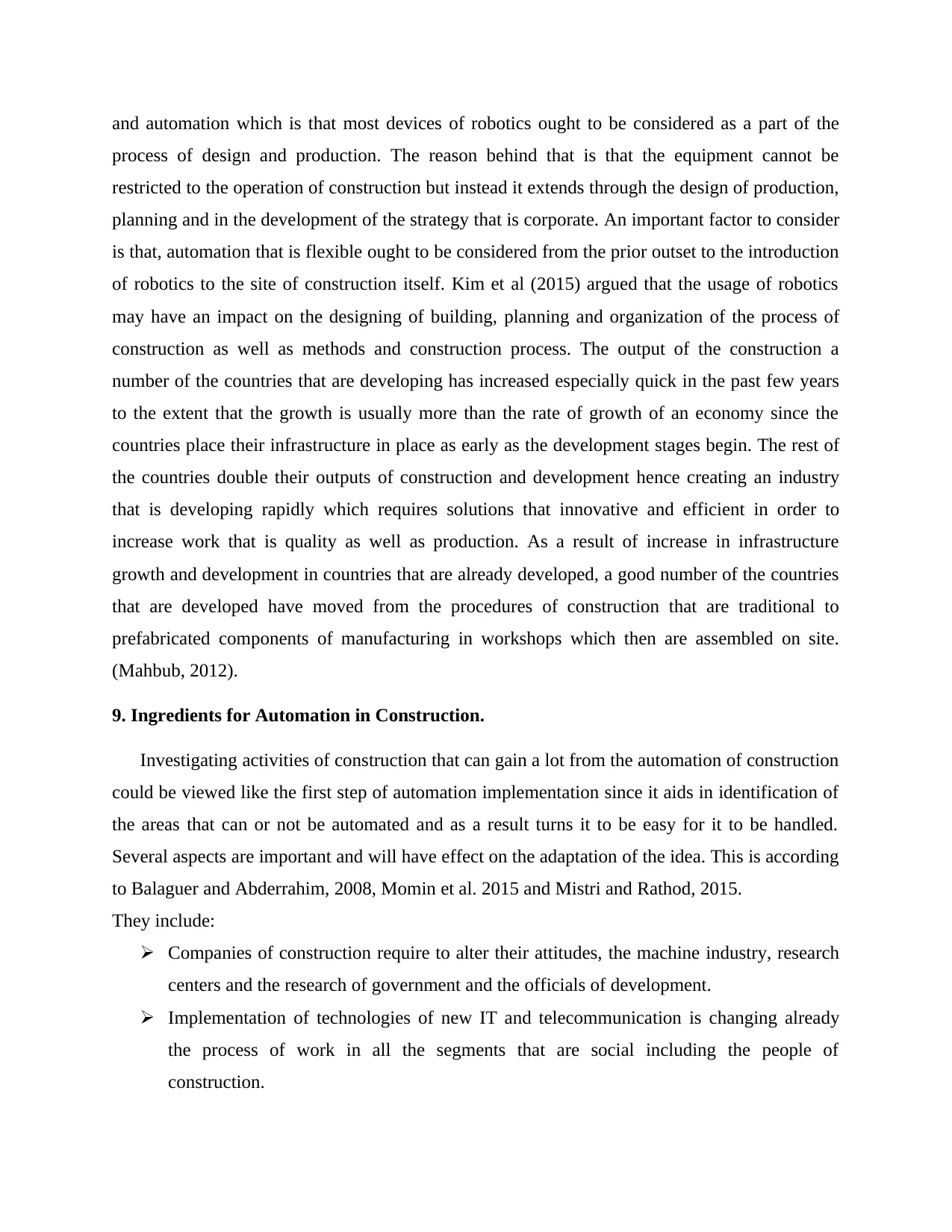
and automation which is that most devices of robotics ought to be considered as a part of the
process of design and production. The reason behind that is that the equipment cannot be
restricted to the operation of construction but instead it extends through the design of production,
planning and in the development of the strategy that is corporate. An important factor to consider
is that, automation that is flexible ought to be considered from the prior outset to the introduction
of robotics to the site of construction itself. Kim et al (2015) argued that the usage of robotics
may have an impact on the designing of building, planning and organization of the process of
construction as well as methods and construction process. The output of the construction a
number of the countries that are developing has increased especially quick in the past few years
to the extent that the growth is usually more than the rate of growth of an economy since the
countries place their infrastructure in place as early as the development stages begin. The rest of
the countries double their outputs of construction and development hence creating an industry
that is developing rapidly which requires solutions that innovative and efficient in order to
increase work that is quality as well as production. As a result of increase in infrastructure
growth and development in countries that are already developed, a good number of the countries
that are developed have moved from the procedures of construction that are traditional to
prefabricated components of manufacturing in workshops which then are assembled on site.
(Mahbub, 2012).
9. Ingredients for Automation in Construction.
Investigating activities of construction that can gain a lot from the automation of construction
could be viewed like the first step of automation implementation since it aids in identification of
the areas that can or not be automated and as a result turns it to be easy for it to be handled.
Several aspects are important and will have effect on the adaptation of the idea. This is according
to Balaguer and Abderrahim, 2008, Momin et al. 2015 and Mistri and Rathod, 2015.
They include:
Companies of construction require to alter their attitudes, the machine industry, research
centers and the research of government and the officials of development.
Implementation of technologies of new IT and telecommunication is changing already
the process of work in all the segments that are social including the people of
construction.
process of design and production. The reason behind that is that the equipment cannot be
restricted to the operation of construction but instead it extends through the design of production,
planning and in the development of the strategy that is corporate. An important factor to consider
is that, automation that is flexible ought to be considered from the prior outset to the introduction
of robotics to the site of construction itself. Kim et al (2015) argued that the usage of robotics
may have an impact on the designing of building, planning and organization of the process of
construction as well as methods and construction process. The output of the construction a
number of the countries that are developing has increased especially quick in the past few years
to the extent that the growth is usually more than the rate of growth of an economy since the
countries place their infrastructure in place as early as the development stages begin. The rest of
the countries double their outputs of construction and development hence creating an industry
that is developing rapidly which requires solutions that innovative and efficient in order to
increase work that is quality as well as production. As a result of increase in infrastructure
growth and development in countries that are already developed, a good number of the countries
that are developed have moved from the procedures of construction that are traditional to
prefabricated components of manufacturing in workshops which then are assembled on site.
(Mahbub, 2012).
9. Ingredients for Automation in Construction.
Investigating activities of construction that can gain a lot from the automation of construction
could be viewed like the first step of automation implementation since it aids in identification of
the areas that can or not be automated and as a result turns it to be easy for it to be handled.
Several aspects are important and will have effect on the adaptation of the idea. This is according
to Balaguer and Abderrahim, 2008, Momin et al. 2015 and Mistri and Rathod, 2015.
They include:
Companies of construction require to alter their attitudes, the machine industry, research
centers and the research of government and the officials of development.
Implementation of technologies of new IT and telecommunication is changing already
the process of work in all the segments that are social including the people of
construction.
⊘ This is a preview!⊘
Do you want full access?
Subscribe today to unlock all pages.

Trusted by 1+ million students worldwide
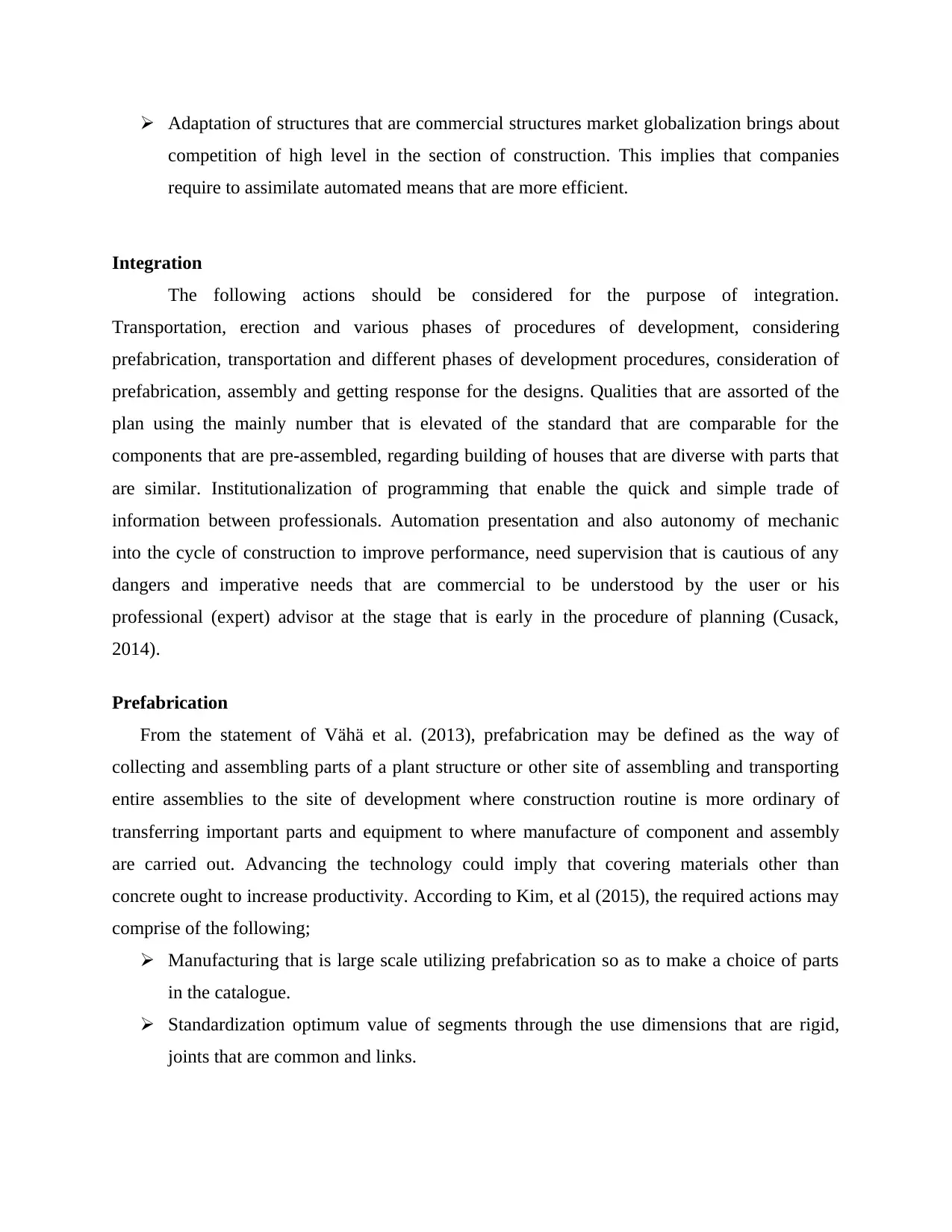
Adaptation of structures that are commercial structures market globalization brings about
competition of high level in the section of construction. This implies that companies
require to assimilate automated means that are more efficient.
Integration
The following actions should be considered for the purpose of integration.
Transportation, erection and various phases of procedures of development, considering
prefabrication, transportation and different phases of development procedures, consideration of
prefabrication, assembly and getting response for the designs. Qualities that are assorted of the
plan using the mainly number that is elevated of the standard that are comparable for the
components that are pre-assembled, regarding building of houses that are diverse with parts that
are similar. Institutionalization of programming that enable the quick and simple trade of
information between professionals. Automation presentation and also autonomy of mechanic
into the cycle of construction to improve performance, need supervision that is cautious of any
dangers and imperative needs that are commercial to be understood by the user or his
professional (expert) advisor at the stage that is early in the procedure of planning (Cusack,
2014).
Prefabrication
From the statement of Vähä et al. (2013), prefabrication may be defined as the way of
collecting and assembling parts of a plant structure or other site of assembling and transporting
entire assemblies to the site of development where construction routine is more ordinary of
transferring important parts and equipment to where manufacture of component and assembly
are carried out. Advancing the technology could imply that covering materials other than
concrete ought to increase productivity. According to Kim, et al (2015), the required actions may
comprise of the following;
Manufacturing that is large scale utilizing prefabrication so as to make a choice of parts
in the catalogue.
Standardization optimum value of segments through the use dimensions that are rigid,
joints that are common and links.
competition of high level in the section of construction. This implies that companies
require to assimilate automated means that are more efficient.
Integration
The following actions should be considered for the purpose of integration.
Transportation, erection and various phases of procedures of development, considering
prefabrication, transportation and different phases of development procedures, consideration of
prefabrication, assembly and getting response for the designs. Qualities that are assorted of the
plan using the mainly number that is elevated of the standard that are comparable for the
components that are pre-assembled, regarding building of houses that are diverse with parts that
are similar. Institutionalization of programming that enable the quick and simple trade of
information between professionals. Automation presentation and also autonomy of mechanic
into the cycle of construction to improve performance, need supervision that is cautious of any
dangers and imperative needs that are commercial to be understood by the user or his
professional (expert) advisor at the stage that is early in the procedure of planning (Cusack,
2014).
Prefabrication
From the statement of Vähä et al. (2013), prefabrication may be defined as the way of
collecting and assembling parts of a plant structure or other site of assembling and transporting
entire assemblies to the site of development where construction routine is more ordinary of
transferring important parts and equipment to where manufacture of component and assembly
are carried out. Advancing the technology could imply that covering materials other than
concrete ought to increase productivity. According to Kim, et al (2015), the required actions may
comprise of the following;
Manufacturing that is large scale utilizing prefabrication so as to make a choice of parts
in the catalogue.
Standardization optimum value of segments through the use dimensions that are rigid,
joints that are common and links.
Paraphrase This Document
Need a fresh take? Get an instant paraphrase of this document with our AI Paraphraser
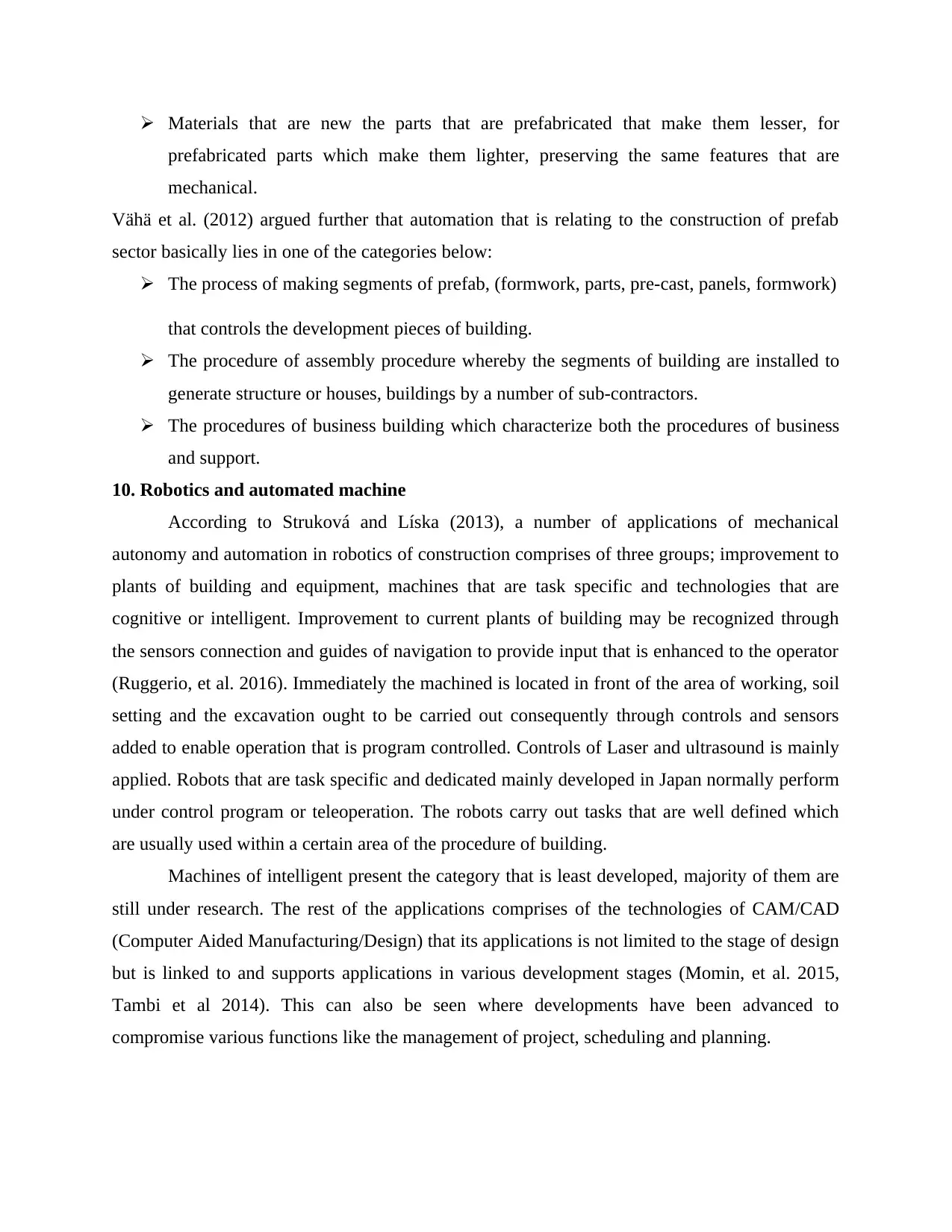
Materials that are new the parts that are prefabricated that make them lesser, for
prefabricated parts which make them lighter, preserving the same features that are
mechanical.
Vähä et al. (2012) argued further that automation that is relating to the construction of prefab
sector basically lies in one of the categories below:
The process of making segments of prefab, (formwork, parts, pre-cast, panels, formwork)
that controls the development pieces of building.
The procedure of assembly procedure whereby the segments of building are installed to
generate structure or houses, buildings by a number of sub-contractors.
The procedures of business building which characterize both the procedures of business
and support.
10. Robotics and automated machine
According to Struková and Líska (2013), a number of applications of mechanical
autonomy and automation in robotics of construction comprises of three groups; improvement to
plants of building and equipment, machines that are task specific and technologies that are
cognitive or intelligent. Improvement to current plants of building may be recognized through
the sensors connection and guides of navigation to provide input that is enhanced to the operator
(Ruggerio, et al. 2016). Immediately the machined is located in front of the area of working, soil
setting and the excavation ought to be carried out consequently through controls and sensors
added to enable operation that is program controlled. Controls of Laser and ultrasound is mainly
applied. Robots that are task specific and dedicated mainly developed in Japan normally perform
under control program or teleoperation. The robots carry out tasks that are well defined which
are usually used within a certain area of the procedure of building.
Machines of intelligent present the category that is least developed, majority of them are
still under research. The rest of the applications comprises of the technologies of CAM/CAD
(Computer Aided Manufacturing/Design) that its applications is not limited to the stage of design
but is linked to and supports applications in various development stages (Momin, et al. 2015,
Tambi et al 2014). This can also be seen where developments have been advanced to
compromise various functions like the management of project, scheduling and planning.
prefabricated parts which make them lighter, preserving the same features that are
mechanical.
Vähä et al. (2012) argued further that automation that is relating to the construction of prefab
sector basically lies in one of the categories below:
The process of making segments of prefab, (formwork, parts, pre-cast, panels, formwork)
that controls the development pieces of building.
The procedure of assembly procedure whereby the segments of building are installed to
generate structure or houses, buildings by a number of sub-contractors.
The procedures of business building which characterize both the procedures of business
and support.
10. Robotics and automated machine
According to Struková and Líska (2013), a number of applications of mechanical
autonomy and automation in robotics of construction comprises of three groups; improvement to
plants of building and equipment, machines that are task specific and technologies that are
cognitive or intelligent. Improvement to current plants of building may be recognized through
the sensors connection and guides of navigation to provide input that is enhanced to the operator
(Ruggerio, et al. 2016). Immediately the machined is located in front of the area of working, soil
setting and the excavation ought to be carried out consequently through controls and sensors
added to enable operation that is program controlled. Controls of Laser and ultrasound is mainly
applied. Robots that are task specific and dedicated mainly developed in Japan normally perform
under control program or teleoperation. The robots carry out tasks that are well defined which
are usually used within a certain area of the procedure of building.
Machines of intelligent present the category that is least developed, majority of them are
still under research. The rest of the applications comprises of the technologies of CAM/CAD
(Computer Aided Manufacturing/Design) that its applications is not limited to the stage of design
but is linked to and supports applications in various development stages (Momin, et al. 2015,
Tambi et al 2014). This can also be seen where developments have been advanced to
compromise various functions like the management of project, scheduling and planning.
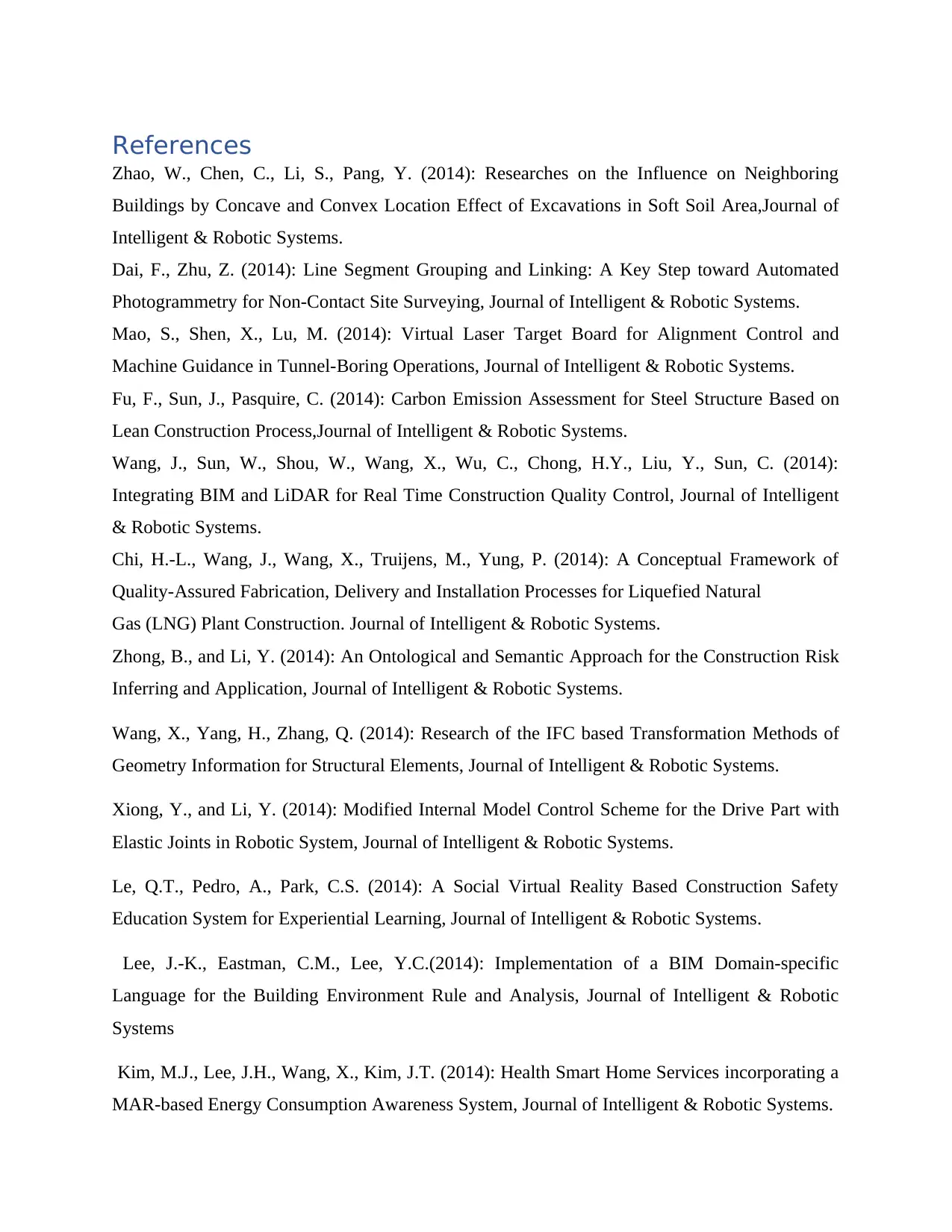
References
Zhao, W., Chen, C., Li, S., Pang, Y. (2014): Researches on the Influence on Neighboring
Buildings by Concave and Convex Location Effect of Excavations in Soft Soil Area,Journal of
Intelligent & Robotic Systems.
Dai, F., Zhu, Z. (2014): Line Segment Grouping and Linking: A Key Step toward Automated
Photogrammetry for Non-Contact Site Surveying, Journal of Intelligent & Robotic Systems.
Mao, S., Shen, X., Lu, M. (2014): Virtual Laser Target Board for Alignment Control and
Machine Guidance in Tunnel-Boring Operations, Journal of Intelligent & Robotic Systems.
Fu, F., Sun, J., Pasquire, C. (2014): Carbon Emission Assessment for Steel Structure Based on
Lean Construction Process,Journal of Intelligent & Robotic Systems.
Wang, J., Sun, W., Shou, W., Wang, X., Wu, C., Chong, H.Y., Liu, Y., Sun, C. (2014):
Integrating BIM and LiDAR for Real Time Construction Quality Control, Journal of Intelligent
& Robotic Systems.
Chi, H.-L., Wang, J., Wang, X., Truijens, M., Yung, P. (2014): A Conceptual Framework of
Quality-Assured Fabrication, Delivery and Installation Processes for Liquefied Natural
Gas (LNG) Plant Construction. Journal of Intelligent & Robotic Systems.
Zhong, B., and Li, Y. (2014): An Ontological and Semantic Approach for the Construction Risk
Inferring and Application, Journal of Intelligent & Robotic Systems.
Wang, X., Yang, H., Zhang, Q. (2014): Research of the IFC based Transformation Methods of
Geometry Information for Structural Elements, Journal of Intelligent & Robotic Systems.
Xiong, Y., and Li, Y. (2014): Modified Internal Model Control Scheme for the Drive Part with
Elastic Joints in Robotic System, Journal of Intelligent & Robotic Systems.
Le, Q.T., Pedro, A., Park, C.S. (2014): A Social Virtual Reality Based Construction Safety
Education System for Experiential Learning, Journal of Intelligent & Robotic Systems.
Lee, J.-K., Eastman, C.M., Lee, Y.C.(2014): Implementation of a BIM Domain-specific
Language for the Building Environment Rule and Analysis, Journal of Intelligent & Robotic
Systems
Kim, M.J., Lee, J.H., Wang, X., Kim, J.T. (2014): Health Smart Home Services incorporating a
MAR-based Energy Consumption Awareness System, Journal of Intelligent & Robotic Systems.
Zhao, W., Chen, C., Li, S., Pang, Y. (2014): Researches on the Influence on Neighboring
Buildings by Concave and Convex Location Effect of Excavations in Soft Soil Area,Journal of
Intelligent & Robotic Systems.
Dai, F., Zhu, Z. (2014): Line Segment Grouping and Linking: A Key Step toward Automated
Photogrammetry for Non-Contact Site Surveying, Journal of Intelligent & Robotic Systems.
Mao, S., Shen, X., Lu, M. (2014): Virtual Laser Target Board for Alignment Control and
Machine Guidance in Tunnel-Boring Operations, Journal of Intelligent & Robotic Systems.
Fu, F., Sun, J., Pasquire, C. (2014): Carbon Emission Assessment for Steel Structure Based on
Lean Construction Process,Journal of Intelligent & Robotic Systems.
Wang, J., Sun, W., Shou, W., Wang, X., Wu, C., Chong, H.Y., Liu, Y., Sun, C. (2014):
Integrating BIM and LiDAR for Real Time Construction Quality Control, Journal of Intelligent
& Robotic Systems.
Chi, H.-L., Wang, J., Wang, X., Truijens, M., Yung, P. (2014): A Conceptual Framework of
Quality-Assured Fabrication, Delivery and Installation Processes for Liquefied Natural
Gas (LNG) Plant Construction. Journal of Intelligent & Robotic Systems.
Zhong, B., and Li, Y. (2014): An Ontological and Semantic Approach for the Construction Risk
Inferring and Application, Journal of Intelligent & Robotic Systems.
Wang, X., Yang, H., Zhang, Q. (2014): Research of the IFC based Transformation Methods of
Geometry Information for Structural Elements, Journal of Intelligent & Robotic Systems.
Xiong, Y., and Li, Y. (2014): Modified Internal Model Control Scheme for the Drive Part with
Elastic Joints in Robotic System, Journal of Intelligent & Robotic Systems.
Le, Q.T., Pedro, A., Park, C.S. (2014): A Social Virtual Reality Based Construction Safety
Education System for Experiential Learning, Journal of Intelligent & Robotic Systems.
Lee, J.-K., Eastman, C.M., Lee, Y.C.(2014): Implementation of a BIM Domain-specific
Language for the Building Environment Rule and Analysis, Journal of Intelligent & Robotic
Systems
Kim, M.J., Lee, J.H., Wang, X., Kim, J.T. (2014): Health Smart Home Services incorporating a
MAR-based Energy Consumption Awareness System, Journal of Intelligent & Robotic Systems.
⊘ This is a preview!⊘
Do you want full access?
Subscribe today to unlock all pages.

Trusted by 1+ million students worldwide
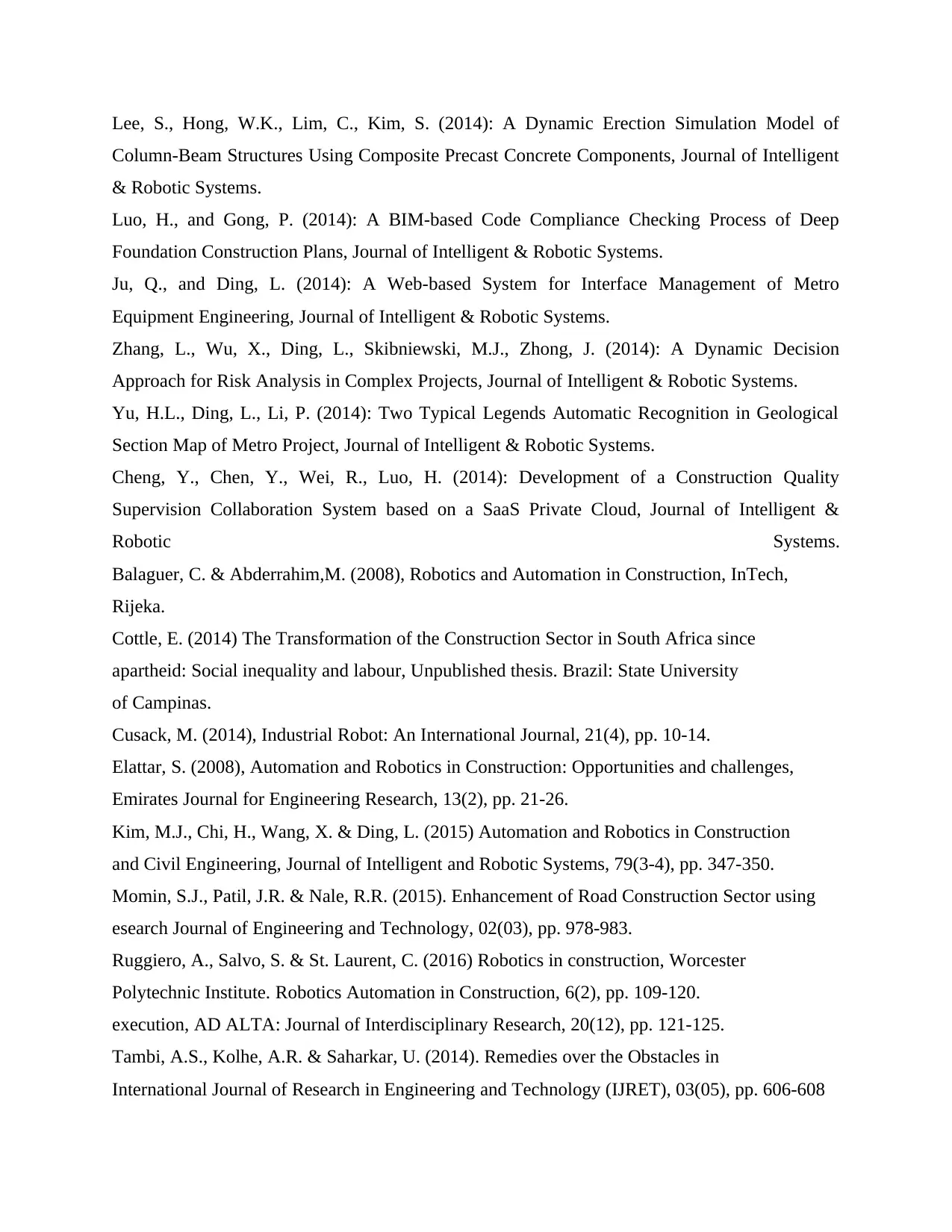
Lee, S., Hong, W.K., Lim, C., Kim, S. (2014): A Dynamic Erection Simulation Model of
Column-Beam Structures Using Composite Precast Concrete Components, Journal of Intelligent
& Robotic Systems.
Luo, H., and Gong, P. (2014): A BIM-based Code Compliance Checking Process of Deep
Foundation Construction Plans, Journal of Intelligent & Robotic Systems.
Ju, Q., and Ding, L. (2014): A Web-based System for Interface Management of Metro
Equipment Engineering, Journal of Intelligent & Robotic Systems.
Zhang, L., Wu, X., Ding, L., Skibniewski, M.J., Zhong, J. (2014): A Dynamic Decision
Approach for Risk Analysis in Complex Projects, Journal of Intelligent & Robotic Systems.
Yu, H.L., Ding, L., Li, P. (2014): Two Typical Legends Automatic Recognition in Geological
Section Map of Metro Project, Journal of Intelligent & Robotic Systems.
Cheng, Y., Chen, Y., Wei, R., Luo, H. (2014): Development of a Construction Quality
Supervision Collaboration System based on a SaaS Private Cloud, Journal of Intelligent &
Robotic Systems.
Balaguer, C. & Abderrahim,M. (2008), Robotics and Automation in Construction, InTech,
Rijeka.
Cottle, E. (2014) The Transformation of the Construction Sector in South Africa since
apartheid: Social inequality and labour, Unpublished thesis. Brazil: State University
of Campinas.
Cusack, M. (2014), Industrial Robot: An International Journal, 21(4), pp. 10-14.
Elattar, S. (2008), Automation and Robotics in Construction: Opportunities and challenges,
Emirates Journal for Engineering Research, 13(2), pp. 21-26.
Kim, M.J., Chi, H., Wang, X. & Ding, L. (2015) Automation and Robotics in Construction
and Civil Engineering, Journal of Intelligent and Robotic Systems, 79(3-4), pp. 347-350.
Momin, S.J., Patil, J.R. & Nale, R.R. (2015). Enhancement of Road Construction Sector using
esearch Journal of Engineering and Technology, 02(03), pp. 978-983.
Ruggiero, A., Salvo, S. & St. Laurent, C. (2016) Robotics in construction, Worcester
Polytechnic Institute. Robotics Automation in Construction, 6(2), pp. 109-120.
execution, AD ALTA: Journal of Interdisciplinary Research, 20(12), pp. 121-125.
Tambi, A.S., Kolhe, A.R. & Saharkar, U. (2014). Remedies over the Obstacles in
International Journal of Research in Engineering and Technology (IJRET), 03(05), pp. 606-608
Column-Beam Structures Using Composite Precast Concrete Components, Journal of Intelligent
& Robotic Systems.
Luo, H., and Gong, P. (2014): A BIM-based Code Compliance Checking Process of Deep
Foundation Construction Plans, Journal of Intelligent & Robotic Systems.
Ju, Q., and Ding, L. (2014): A Web-based System for Interface Management of Metro
Equipment Engineering, Journal of Intelligent & Robotic Systems.
Zhang, L., Wu, X., Ding, L., Skibniewski, M.J., Zhong, J. (2014): A Dynamic Decision
Approach for Risk Analysis in Complex Projects, Journal of Intelligent & Robotic Systems.
Yu, H.L., Ding, L., Li, P. (2014): Two Typical Legends Automatic Recognition in Geological
Section Map of Metro Project, Journal of Intelligent & Robotic Systems.
Cheng, Y., Chen, Y., Wei, R., Luo, H. (2014): Development of a Construction Quality
Supervision Collaboration System based on a SaaS Private Cloud, Journal of Intelligent &
Robotic Systems.
Balaguer, C. & Abderrahim,M. (2008), Robotics and Automation in Construction, InTech,
Rijeka.
Cottle, E. (2014) The Transformation of the Construction Sector in South Africa since
apartheid: Social inequality and labour, Unpublished thesis. Brazil: State University
of Campinas.
Cusack, M. (2014), Industrial Robot: An International Journal, 21(4), pp. 10-14.
Elattar, S. (2008), Automation and Robotics in Construction: Opportunities and challenges,
Emirates Journal for Engineering Research, 13(2), pp. 21-26.
Kim, M.J., Chi, H., Wang, X. & Ding, L. (2015) Automation and Robotics in Construction
and Civil Engineering, Journal of Intelligent and Robotic Systems, 79(3-4), pp. 347-350.
Momin, S.J., Patil, J.R. & Nale, R.R. (2015). Enhancement of Road Construction Sector using
esearch Journal of Engineering and Technology, 02(03), pp. 978-983.
Ruggiero, A., Salvo, S. & St. Laurent, C. (2016) Robotics in construction, Worcester
Polytechnic Institute. Robotics Automation in Construction, 6(2), pp. 109-120.
execution, AD ALTA: Journal of Interdisciplinary Research, 20(12), pp. 121-125.
Tambi, A.S., Kolhe, A.R. & Saharkar, U. (2014). Remedies over the Obstacles in
International Journal of Research in Engineering and Technology (IJRET), 03(05), pp. 606-608
Paraphrase This Document
Need a fresh take? Get an instant paraphrase of this document with our AI Paraphraser
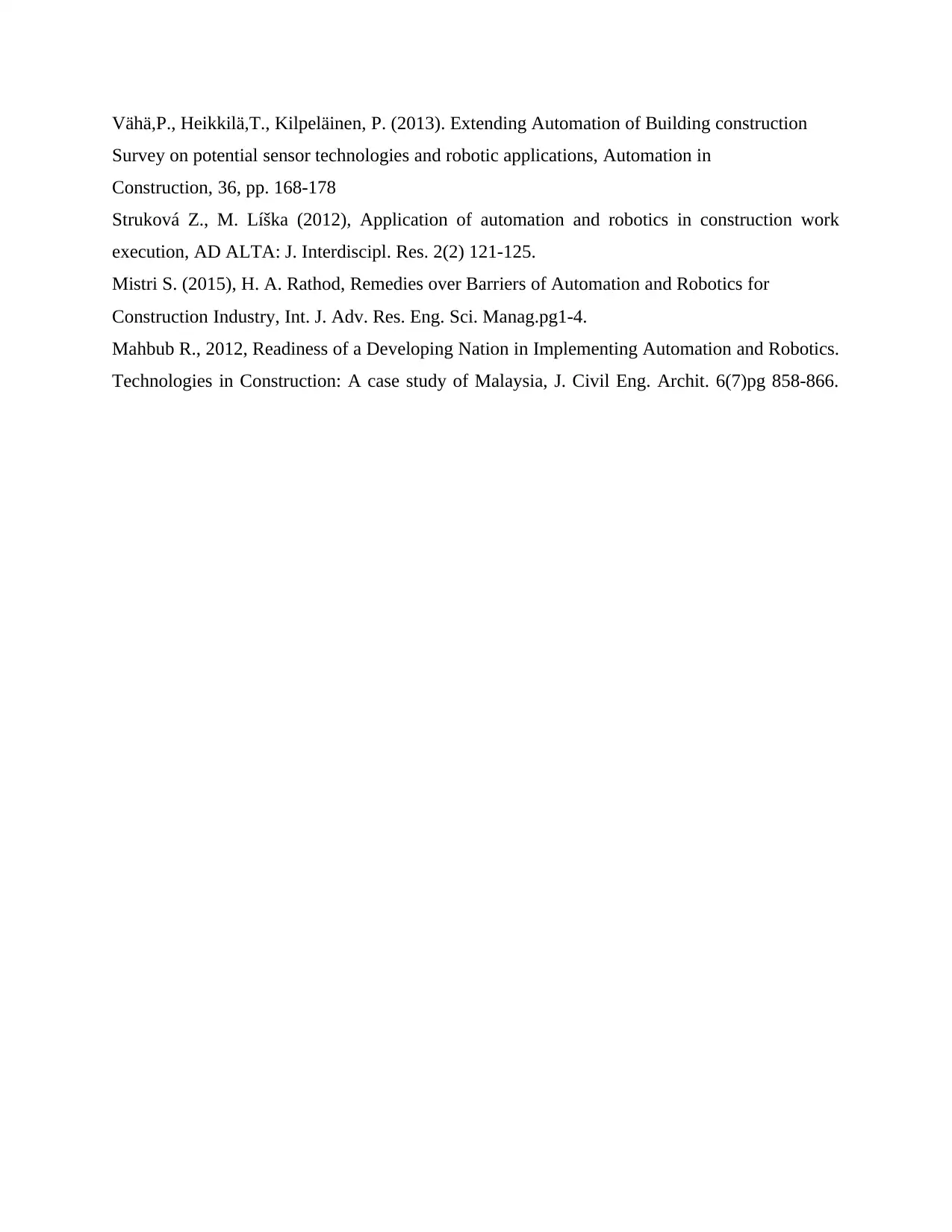
Vähä,P., Heikkilä,T., Kilpeläinen, P. (2013). Extending Automation of Building construction
Survey on potential sensor technologies and robotic applications, Automation in
Construction, 36, pp. 168-178
Struková Z., M. Líška (2012), Application of automation and robotics in construction work
execution, AD ALTA: J. Interdiscipl. Res. 2(2) 121-125.
Mistri S. (2015), H. A. Rathod, Remedies over Barriers of Automation and Robotics for
Construction Industry, Int. J. Adv. Res. Eng. Sci. Manag.pg1-4.
Mahbub R., 2012, Readiness of a Developing Nation in Implementing Automation and Robotics.
Technologies in Construction: A case study of Malaysia, J. Civil Eng. Archit. 6(7)pg 858-866.
Survey on potential sensor technologies and robotic applications, Automation in
Construction, 36, pp. 168-178
Struková Z., M. Líška (2012), Application of automation and robotics in construction work
execution, AD ALTA: J. Interdiscipl. Res. 2(2) 121-125.
Mistri S. (2015), H. A. Rathod, Remedies over Barriers of Automation and Robotics for
Construction Industry, Int. J. Adv. Res. Eng. Sci. Manag.pg1-4.
Mahbub R., 2012, Readiness of a Developing Nation in Implementing Automation and Robotics.
Technologies in Construction: A case study of Malaysia, J. Civil Eng. Archit. 6(7)pg 858-866.

⊘ This is a preview!⊘
Do you want full access?
Subscribe today to unlock all pages.

Trusted by 1+ million students worldwide
1 out of 12
Related Documents
Your All-in-One AI-Powered Toolkit for Academic Success.
+13062052269
info@desklib.com
Available 24*7 on WhatsApp / Email
![[object Object]](/_next/static/media/star-bottom.7253800d.svg)
Unlock your academic potential
Copyright © 2020–2025 A2Z Services. All Rights Reserved. Developed and managed by ZUCOL.





